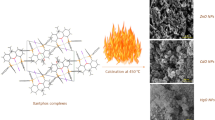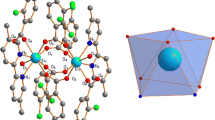Abstract
A heterogeneous distribution study with internally formed lead chromate as host and110Ag as guest indicates the existence of a new variety of lead chromate, which forms mixed crystals with silver chromate, and differs in morphology from the aged variety. It is inferred that the formation of mixed crystals is probably due to breeding of a morphologically analogous and unstable species by the guest component. By means of study of the homogeneous distribution coefficient, D, of the system consisting of KFe(SO4)2·12H2O as host and110Ag as guest, the existence of an unknown alum, AgFe(SO4)2·12H2O, in trace amounts has been demonstrated. A distribution study of the system shows that KFe(SO4)2·12H2O forms mixed crystals with110Ag up to 10°C, after which the uptake follows an adsorption pattern. The transition temperature of the guest alum, indicated by a sharp change in the D values, is found to be 10°C. Application of radioactive tracers in the study of new and unstable compounds have been stressed.
Similar content being viewed by others
References
O. Hahn, Applied Radiochemistry. Cornell Univ. Press, Ithaca, N. Y., 1936.
O. Hahn, H. Kading, R. Mumbrauer, Sitzber. Preuss. Akad. Wiss., Phys. Math. Klasse, (1930) 547.
R. Mumbrauer, Z. Phys. Chem., A163 (1933) 142.
O. Hahn, Z. Elektrochem., 38 (1932) 511.
B. C. Purkayastha, S. N. Bhattacharyya, J. Inorg. Nucl. Chem., 10 (1959) 103.
B. C. Purkayastha, K. N. Dutta, Indian J. Appl. Chem., 26 (1963) 1.
B. C. Purkayastha, S. N. Bhattacharyya, J. Indian Chem. Soc., 41 (1964) 69.
B. C. Purkayastha, K. N. Dutta, Indian J. Appl. Chem., 26 (1963) 133.
B. C. Purkayastha, S. Sarkar, J. Inorg. Nucl. Chem., 28 (1966) 347.
B. C. Purkayastha, N. Das, J. Indian Chem. Soc., 48 (1971) 1.
B. C. Purkayastha, N. Das, J. Indian Chem. Soc., 49 (1972) 3.
H. Doerner, W. J. Hoskins, J. Amer. Chem. Soc., 47 (1925) 662.
L. Henderson, F. Kracek, J. Amer. Chem. Soc., 49 (1927) 738.
W. Bastick, Pharm. J., 13 (1954) 639.
J. Locke, Amer. Chem. J., 26 (1901) 166, 332.
B. C. Purkayastha, N. Das, Australian J. Chem., 26 (1973) 1243.
Author information
Authors and Affiliations
Rights and permissions
About this article
Cite this article
Purkayastha, B.C., Das, N. The study of the existence of unknown and unstable compounds through mixed crystal formation using radioactive tracers. J. Radioanal. Chem. 20, 489–497 (1974). https://doi.org/10.1007/BF02514295
Received:
Issue Date:
DOI: https://doi.org/10.1007/BF02514295




